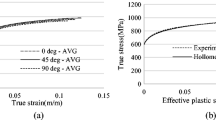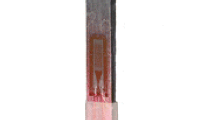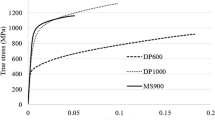Abstract
Roll forming has been used traditionally in the construction and housing industry for the production of longitudinal components but is now increasingly applied in the automotive industry for the manufacture of structural and crash components from ultra high-strength steel (UHSS); the incremental nature of this process allows these hard-to-form materials to be shaped with higher efficiency and less shape defects than observed in common sheet forming processes such as stamping. Tight dimensional tolerances are imposed on automotive components, and this can lead to problems when roll forming UHSS where the high material strength results in shape defect and forming problems. Recent work has therefore increasingly focused on developing process monitoring and control routines for roll forming to improve process robustness and part quality. In roll forming, the longitudinal edge strain is considered to be related to product defects such as bow, twist and end flare. Process and part shape parameters have been shown to significantly influence peak longitudinal edge strain, and the link between process and product parameters, longitudinal edge strain and shape defects needs to be understood for the roll forming of UHSS if routines for process monitoring and control are to be established. Previous studies were mainly focused on traditional roll forming materials used for building products and the like. In this paper, the effect of process and part shape parameters on the peak longitudinal edge strain, longitudinal bow and springback is experimentally and statistically investigated for three different advanced high-strength steel (AHSS) and UHSS commonly used in automotive manufacturing. The results show that there are significant differences in behaviour when forming UHSS and that forming trends differ from those reported for softer steel grades. The experimental data presented in this paper should contribute to the further development of advanced process monitoring and part shape quality control routines in the roll forming AHSS and UHSS.
Similar content being viewed by others
References
Troive L, Ingvarsson L (2008) Roll forming and the benefits of ultrahigh strength steel. Ironmaking & Steelmaking 35:251–253
Weiss M, Marnette J, Wolfram P, Larrañaga J, Hodgson PD (2012) Comparison of bending of automotive steels in roll forming and in a V-die. Key Eng Mater 504:797–802
Badr OM, Rolfe B, Hodgson P, Weiss M (2013) Experimental study into the correlation between the incremental forming and the nature of springback in automotive steels. Int J Mater Prod Technol 47:150–161
Badr OM, Rolfe B, Hodgson P, and Weiss M (2015) Forming of high strength titanium sheet at room temperature, Materials & Design, vol. 66, Part B, pp. 618–626.
Groche P, Beiter P, Henkelmann M (2008) Prediction and inline compensation of springback in roll forming of high and ultra-high strength steels. Prod Eng 2:401–407
Abeyrathna B, Rolfe B, Hodgson P, Weiss M (2016) A first step towards a simple in-line shape compensation routine for the roll forming of high strength steel. Int J Mater Form 9:423–434
Halmos GT (1983) Roll forming HSLA steels. HSLA Steels, Technology and Applications, pp 515–522
Halmos GT (2006) Roll forming handbook. London Taylor & Francis.
Heok YC (1983) Roll forming of metals, Master of Engineering Master, Department of Mechanical Engineering, University of Auckland,
Bhattacharyya D, Smith PD (1984) The development of longitudinal strain in cold roll forming and its influence on product straightness. Advanced Technology of Plasticity 1:422–427
Fong CK (1984) Cold roll forming, Master of Engineering, Department of Mechanical Engineering, Auckland University,
Zhu SD, Panton SM, Duncan JL (1996) The effects of geometric variables in roll forming a channel section. J Eng Manuf 210:127–134
Lindgren M (2007) An improved model for the longitudinal peak strain in the flange of a rollformed U-channel developed by FE-analyses, Steel Research International, vol. 78.
Han ZW, Liu C, Lu WP, Ren LQ (2001) The effects of forming parameters in the roll-forming of a channel section with an outer edge. J Mater Process Technol 116:205–210
Han ZW, Liu C, Lu WP, Ren LQ, Tong J (2005) Spline finite strip analysis of forming parameters in roll forming a channel section. J Mater Process Technol 159:383–388
Paralikas J, Salonitis K, Chryssolouris G (2009) Investigation of the effects of main roll-forming process parameters on quality for a V-section profile from AHSS. Int J Adv Manuf Technol 44:223–237
Azizitafti R, Weiss M, Naeini HM, and Tehrani MS (2012) The effect of material and geometric variables on the straightness of a roll formed channel, presented at the International Conference on Advances in Materials and Processing Technologies, Wollongong.
Lindgren M (2007) Cold roll forming of a U-channel made of high strength steel. J Mater Process Technol 186:77–81
Kiuchi M (1999) Deformation characteristics of metal strips in roll forming, presented at the Tubemaking for Asia’s recovery: International conference, Singapore.
Abeyrathna B, Rolfe B, Hodgson PD, Weiss M (2014) An experimental investigation of edge strain and bow in roll forming a V-section. Mater Sci Forum 773-774(2014):153–159
Kiuchi M (1973) Analytical study on cold-roll-forming process
Groche P, Henkelmann M (2007) Dimensional deviation of roll formed components made of high strength steel. Key Eng Mater 344:285–292
Wen B (2007) Roll forming high-strength materials. The Fabricator.:60–62
Bui QV, Ponthot JP (2008) Numerical simulation of cold roll-forming processes. J Mater Process Technol 202:275–282
Badr OM, Rolfe B, Hodgson P, and Weiss M (2013) Numerical investigation about the effect of increasing the number of forming passes on the quality of AHSS roll formed products, presented at the NUMISHEET 2014: the 9th International Conference and Workshop on Numerical Simulation of 3D Sheet Metal Forming Processes.
ASTM, (2011), Standard test methods for tension testing of metallic materials, ed.
Marciniak Z, Duncan JL, and Hu, J (2002) Mechanics of sheet metal forming: Butterworth-Heinemann.
(2014) TML strain gauges. Available: http://www.tml.jp/
ALMEMO. Available: http://www.ahlborn.com/
(2014). ExaScan 3D scanner. Available: http://www.creaform3d.com/en
Montgomery DC (2008) Design and analysis of experiments: John Wiley & Sons.
Panton SM, Zhu SD, Duncan JL (1994) Fundamental deformation types and sectional properties in roll forming. Int J Mech Sci 36:725–735
Abeyrathna B, Rolfe B, Hodgson P, and Weiss M (2016) Local deformation in roll forming, The International Journal of Advanced Manufacturing Technology, pp. 1–11.
Salonitis K, Paralikas J, Chryssolouris G (2009) Roll forming of AHSS: numerical simulation and investigation of effects of main process parameters on quality. Engineering Against Fracture, pp:327–336
Bhattacharyya D, Smith PD, Yee CH, Collins IF (1984) The prediction of deformation length in cold roll-forming. J Mech Work Technol 9:181–191
Kiuchi M, Nakajima S, and Suzuki H (1972) Experimental investigation on cold-roll-forming process—effects of forming factors and process variables on product shape, forming loads and torques in forming process for fundamental cross-sectional profiles
Galdos L, J. Larranaga, L. Uncilla, H. Lete, and Arrixabalaga G (2009) Process simulation and experimental tests of cold roll forming of a u-channel made of different ultra high strength steel, presented at the Rollform09. 1st international congress on roll forming.
Benson S (2014) The hows and whys of springback and springforward. The Fabricator:90–93
Wolfkamp H, (2014), Australian Rollforming Manufacturers Pty Limited, ed.
Author information
Authors and Affiliations
Corresponding author
Rights and permissions
About this article
Cite this article
Abeyrathna, B., Rolfe, B. & Weiss, M. The effect of process and geometric parameters on longitudinal edge strain and product defects in cold roll forming. Int J Adv Manuf Technol 92, 743–754 (2017). https://doi.org/10.1007/s00170-017-0164-x
Received:
Accepted:
Published:
Issue Date:
DOI: https://doi.org/10.1007/s00170-017-0164-x




